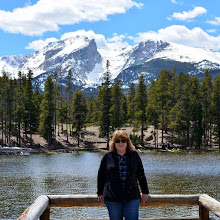I don't decorate for Christmas until after Thanksgiving, so I decorated our Christmas tree on the first few days of December. It is full of sentimental ornaments that bring back many memories as I place them on our tree.
We were happy to have decorated the outside of our home the day after Thanksgiving, as the cold and snow finally arrived! Colorado experienced significant snowfall over several days following a prolonged drought.
We usually leave some leaves on our lawns in late fall, as we have seen the deer dig under the snow to eat them all winter. They are good foragers, and they survive on what they can find in the wild.
Santa Claus visits our community in early December, and although our oldest granddaughter is a few months away from becoming a teenager, she agreed to take photos with him again.
My husband and I joined in, as this might be the last year we see him!
We even get to take a ride in a horse-drawn carriage after seeing Santa Claus!
Our community is about 25 miles west of Denver, located in a valley of the foothills, and on our way back home after seeing Santa Claus, we had this view of dramatic, stormy snow clouds over the city!
This past week, we enjoyed listening to our oldest grandson and oldest granddaughter play the viola in a holiday orchestra production at their schools. They both enjoy music very much!
Our youngest granddaughter enjoys ballet, and her ballet school put on a fabulous production of "The Nutcracker" this week.
Our granddaughter had some solo parts in the dance of the "Russian Candy Canes" segment of the ballet, as seen in the short video above.
She was so excited!
As these assorted decorations proclaim ..."It's beginning to look a lot like Christmas"...and more busy times are ahead!
I'll be writing my Christmas cards, baking some traditional cookies, and making savory zeppole that we serve as appetizers.
I'm sure you are all busy too! Enjoy all the fun!
Blogs I link with:
Nature Notes, Home Matters Linky Party, Ducks in a Row, Monday Morning Blog Club, Good Random Fun, Talk About It Tuesday, The Happy Now Tuesday, Wordless Wednesday, Wordless Wednesday 2, Wednesday My Corner of the World, Wonderful Wednesday, Thankful Thursday, Little Things Thursday, Thursday Favorite Things, Skywatch Friday, Fantastic Friday, Farmhouse Friday, Crazy Little Lovebirds Friday Link Up, Dare to Share, Saturday Sparks, Saturday Critters,









-COLLAGE.jpg)































